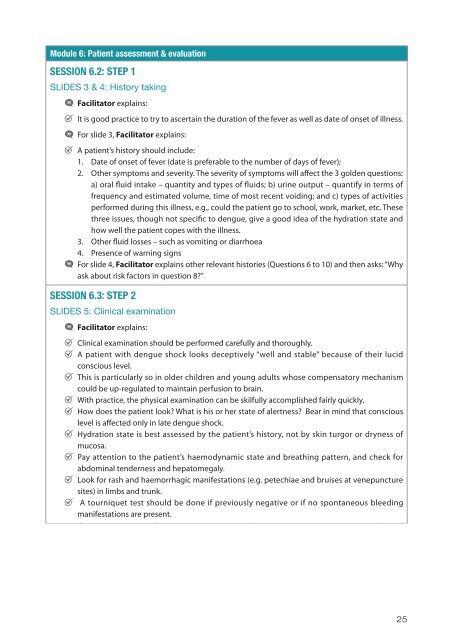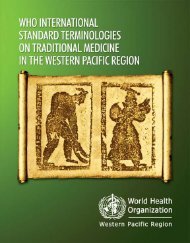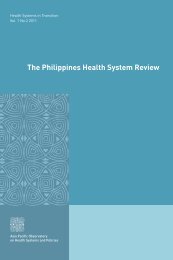Facilitator - WHO Western Pacific Region - World Health Organization
Facilitator - WHO Western Pacific Region - World Health Organization
Facilitator - WHO Western Pacific Region - World Health Organization
Create successful ePaper yourself
Turn your PDF publications into a flip-book with our unique Google optimized e-Paper software.
Module 6: Patient assessment & evaluation<br />
SESSION 6.2: STEP 1<br />
SLIDES 3 & 4: History taking<br />
•<strong>Facilitator</strong> explains:<br />
•It is good practice to try to ascertain the duration of the fever as well as date of onset of illness.<br />
•For<br />
•<br />
slide 3, <strong>Facilitator</strong> explains:<br />
•A patient’s history should include:<br />
1. Date of onset of fever (date is preferable to the number of days of fever);<br />
2. Other symptoms and severity. The severity of symptoms will affect the 3 golden questions:<br />
a) oral fluid intake – quantity and types of fluids; b) urine output – quantify in terms of<br />
frequency and estimated volume, time of most recent voiding; and c) types of activities<br />
performed during this illness, e.g., could the patient go to school, work, market, etc. These<br />
three issues, though not specific to dengue, give a good idea of the hydration state and<br />
how well the patient copes with the illness.<br />
3. Other fluid losses – such as vomiting or diarrhoea<br />
•<br />
4. Presence of warning signs<br />
•For slide 4, <strong>Facilitator</strong> explains other relevant histories (Questions 6 to 10) and then asks: “Why<br />
ask about risk factors in question 8”<br />
SESSION 6.3: STEP 2<br />
SLIDES 5: Clinical examination<br />
•<strong>Facilitator</strong><br />
•<br />
explains:<br />
•<br />
•Clinical examination should be performed carefully and thoroughly.<br />
•A patient with dengue shock looks deceptively “well and stable” because of their lucid<br />
•<br />
conscious level.<br />
•This is particularly so in older children and young adults whose compensatory mechanism<br />
•<br />
could be up-regulated to maintain perfusion to brain.<br />
•With practice, the physical examination can be skilfully accomplished fairly quickly.<br />
•How does the patient look What is his or her state of alertness Bear in mind that conscious<br />
•<br />
level is affected only in late dengue shock.<br />
•Hydration state is best assessed by the patient’s history, not by skin turgor or dryness of<br />
•<br />
mucosa.<br />
•Pay attention to the patient’s haemodynamic state and breathing pattern, and check for<br />
•<br />
abdominal tenderness and hepatomegaly.<br />
•Look for rash and haemorrhagic manifestations (e.g. petechiae and bruises at venepuncture<br />
••<br />
sites) in limbs and trunk.<br />
A<br />
tourniquet test should be done if previously negative or if no spontaneous bleeding<br />
manifestations are present.<br />
25

















